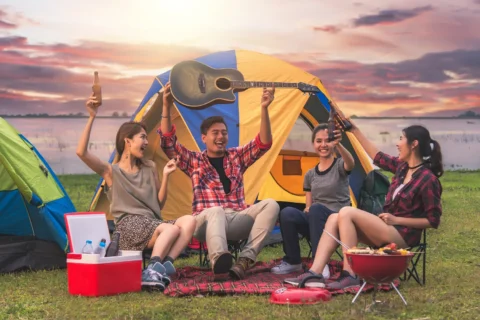Introduction
When venturing into the great outdoors, whether for kayaking, hiking, or camping, protecting your gear from water exposure is crucial. A dry bag waterproof solution offers peace of mind by ensuring your belongings remain dry, regardless of the weather or activity. This comprehensive guide will delve into everything you need to know about dry bags, from their benefits to tips on choosing the best one for your needs.
Understanding Dry Bags
What is a Dry Bag?
A dry bag is a flexible container that provides waterproof protection for your gear. Typically made from materials like PVC, nylon, or vinyl, these bags are designed to keep water out, ensuring that the contents remain dry. The key feature of a dry bag is its roll-top closure, which creates a watertight seal when rolled down and secured.
Why You Need a Dry Bag
Dry bags are essential for anyone engaging in activities near water. They are perfect for kayaking, canoeing, rafting, sailing, and even hiking in wet conditions. By using a dry bag, you protect valuable items like electronics, clothing, and food from water damage, allowing you to focus on enjoying your adventure.
Choosing the Right Dry Bag
Material Matters
The material of your dry bag plays a significant role in its performance and durability. PVC is the most common material, known for its robust waterproof qualities and resistance to punctures. Nylon, often coated with a waterproof layer, offers a lighter and more flexible alternative, making it suitable for activities where weight is a concern.
Size and Capacity
Dry bags come in various sizes, typically measured in liters. The size you choose depends on your specific needs. For day trips, a smaller bag (5-10 liters) may suffice for essentials like your phone, wallet, and snacks. For longer trips, consider larger sizes (20-30 liters) to accommodate clothing, sleeping bags, and other gear.
Closure Systems
The roll-top closure is the most reliable method for waterproof sealing. To use it, you simply roll down the top of the bag three to five times and secure it with a buckle. Some dry bags also feature additional Velcro or zipper seals for added protection, though these are less common.
Using Your Dry Bag Effectively
Packing Your Dry Bag
Proper packing is crucial to maximizing the effectiveness of your dry bag waterproof system. Start by placing heavy items at the bottom and lighter items on top. This ensures stability and makes it easier to roll the top securely. Additionally, avoid overpacking, as this can compromise the seal.
Creating a Watertight Seal
To achieve a watertight seal, roll the top of the dry bag at least three times before securing it with the buckle. Make sure there are no wrinkles or folds that could allow water to seep in. For extra security, consider double bagging sensitive items like electronics in smaller waterproof bags before placing them in your dry bag.
Storing Your Dry Bag
When not in use, store your dry bag in a cool, dry place away from direct sunlight. This prevents the material from degrading over time. Before storing, ensure the bag is completely dry to avoid mold and mildew growth.
Benefits of Using a Dry Bag
Waterproof Protection
The primary benefit of a dry bag is its ability to keep your belongings dry. Whether you’re caught in a downpour or navigating rough waters, a dry bag waterproof solution ensures that your gear stays protected.
Versatility
Dry bags are incredibly versatile. They can be used for a variety of activities, from kayaking and fishing to camping and hiking. Their adaptability makes them an essential piece of gear for outdoor enthusiasts.
Durability
High-quality dry bags are designed to withstand harsh conditions. Made from robust materials, they resist punctures, abrasions, and tears, ensuring long-lasting performance.
Easy to Use
Dry bags are straightforward to use. The roll-top closure system is intuitive and quick, allowing you to seal and unseal the bag efficiently. This simplicity makes them accessible to users of all experience levels.
Tips for Maintaining Your Dry Bag
Regular Cleaning
To prolong the life of your dry bag, clean it regularly. After each use, rinse the bag with fresh water to remove dirt and debris. Avoid using harsh chemicals or detergents that could damage the material.
Inspect for Damage
Before each use, inspect your dry bag for any signs of wear and tear. Look for punctures, abrasions, or weakened seams that could compromise its waterproof capabilities. Address any issues promptly to maintain the integrity of the bag.
Proper Drying
After cleaning, allow your dry bag to air dry completely before storing it. This prevents mold and mildew growth, which can damage the material and compromise the bag’s waterproof properties.
Common Uses for Dry Bags
Water Sports
Dry bags are a staple for water sports enthusiasts. Whether kayaking, canoeing, or rafting, a dry bag waterproof solution keeps your gear dry and safe. They can be strapped to your boat or carried on your person, providing convenient access to essentials.
Hiking and Camping
For hikers and campers, dry bags offer a lightweight and effective way to protect gear from the elements. Use them to store clothing, sleeping bags, and food, ensuring that everything stays dry even in wet conditions.
Beach Trips
When heading to the beach, a dry bag is perfect for keeping your belongings sand-free and dry. Store items like towels, electronics, and snacks in the bag, and enjoy a worry-free day by the water.
Travel
Dry bags are also useful for travel. Use them to separate wet or dirty clothes from clean items in your luggage. Their waterproof properties make them ideal for protecting documents, electronics, and other valuables during your journey.
Advanced Tips for Dry Bag Users
Double Bagging
For added protection, consider double bagging valuable or sensitive items. Place them in a smaller waterproof bag before putting them into your dry bag. This provides an extra layer of security against water infiltration.
Using Desiccants
Including desiccant packets in your dry bag can help control moisture levels. These packets absorb any residual moisture, keeping your gear even drier. This is especially useful for electronics and other sensitive items.
Labeling Your Bags
If you use multiple dry bags, labeling them can help keep your gear organized. Use a waterproof marker to label each bag according to its contents. This makes it easier to locate specific items quickly, especially in large packs or when on the move.
Balancing Load
When packing your dry bag, distribute the weight evenly to ensure comfort and stability. This is particularly important for larger bags that you’ll be carrying for extended periods. An uneven load can cause discomfort and affect your balance.
Frequently Asked Questions
How Do I Know If My Dry Bag is Fully Sealed?
To check if your dry bag is fully sealed, roll down the top at least three times and secure the buckle. Then, press down on the bag to expel any excess air. If no air escapes, your bag is properly sealed.
Can I Submerge My Dry Bag?
While dry bags are designed to be waterproof, they are not typically intended for prolonged submersion. Brief submersion, such as dropping the bag in water, should not compromise its waterproof capabilities. However, avoid keeping the bag submerged for extended periods to ensure the best protection.
How Do I Repair a Punctured Dry Bag?
If your dry bag gets punctured, you can repair it using a waterproof patch kit. Clean and dry the area around the puncture, apply the patch according to the kit instructions, and allow it to cure completely before using the bag again.
What Size Dry Bag Should I Use?
The size of the dry bag you need depends on the duration of your trip and the amount of gear you need to protect. For short trips, a smaller bag (5-10 liters) may be sufficient. For longer excursions, consider larger bags (20-30 liters) to accommodate more gear.
Are Dry Bags Buoyant?
Yes, dry bags can provide some buoyancy, especially when filled with air. However, their primary purpose is to keep your gear dry, not to serve as flotation devices. Always use proper safety equipment for buoyancy in water activities.
Conclusion
Investing in a dry bag waterproof solution is essential for anyone who enjoys outdoor activities. These versatile and durable bags provide unmatched protection for your gear, ensuring that your belongings stay dry no matter the conditions. By choosing the right material, size, and closure system, and following best practices for packing and maintenance, you can maximize the effectiveness of your dry bag. Whether you’re kayaking, hiking, camping, or traveling, a reliable dry bag will give you peace of mind and allow you to focus on enjoying your adventure.










